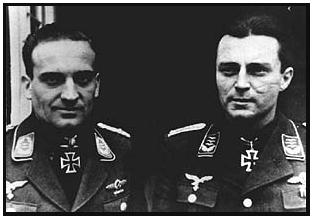

|
Rudel logged 2,530 combat missions, and was granted almost no leave throughout his four years of active duty. Unlike his Allied counterparts, there was no magical number of missions which would mean a furlough home, once attained. For Rudel, as well as for all German pilots, it was a matter of "fly and fight until the war ends, or you are killed": consequently, almost all eventually fell, and today only a tiny handful survive. Rudel's personal victories as a ground-attack pilot were achieved exclusively against the Soviets, and despite the most primitive conditions imaginable, including operations solely from dirt, mud, and snow covered airfields, his confirmed victories (those witnessed by two or more fellow pilots) include: * 518+ Tanks * 700 Trucks * 150+ Flak and Artillery positions * 9 Fighter/Ground Attack Aircraft * Hundreds of bridges, railway lines, bunkers, etc. * Battleship October Revolution , Cruiser Marat and 70 landing craft Through direct action, he saved tens of thousands of German infantrymen from certain encirclement and annihilation during the long retreat which began in July 43 and lasted until the war's end, almost two years later. |
|
* Shot down 32 times. * Innumerable aircraft brought back to base that were later written off, due to heavy combat damage. * Wounded on many occasions, including the partial amputation of his right leg in the Spring of 45, after which he continued to fly with a prosthetic limb. March 44: Disaster struck when Rudel landed behind Soviet lines to retrieve a downed German aircrew. Snow and mud bogged down the airplane, making it impossible to take off. Approaching Soviet troops forced everyone to flee on foot, but barring their escape was the 900 foot wide river Dnjestr. The Germans stripped to their long johns, and swam across the ice-clogged river. Rudel's close friend and crewman, Erwin Henstchel, drowned a few feet from the far shore. They had flown 1490 missions together at the time of Hentschel's death. His body was never recovered. Rudel was pursued by hundreds of Soviet troops who were intent on collecting the 100,000 ruble bounty which Stalin had placed on his head, and he was shot in the shoulder while they chased him with dogs and on horseback. Through incredible ingenuity, audacity, and raw determination, Rudel escaped and made his way, alone and unarmed, back home, despite being more than 30 miles behind Soviet lines when he began his 24 hour trek. He was barefoot and almost naked in the sub-freezing winter weather, without food, compass, or medical attention. His escape stands as the single most legendary example of personal bravery and luck during the Second World War, but he never fully recovered emotionally from Hentschel's death, for which he blamed himself throughout the remainder of his life |
 |
| Hans-Ulrich Rudel (left) with Ernst Gadermann who was Hans-Ulrich Rudel's rear gunner in his Junkers Ju 87 Stuka dive bomber after the death of Henschel in 1944. |
|
Unlike the situation with the Soviets, German decorations were awarded without regard to rank. And in contrast to the Western Allies, they were never awarded for single acts of conspicuous bravery, but rather for a consistent record of personal gallantry and success in combat. * 15 Jan 42: Knight's Cross. * Equivalent of the Congressional Medal of Honor or Britain's Victoria Cross. * 14 Apr 43: Knight's Cross with Oakleaves * Higher level of above, awarded rarely. * 25 Nov 44: Knight's Cross with Oakleaves & Swords * Won by those who had performed the most extreme acts of personal gallantry on a daily basis. Awarded very rarely: most often posthumously. * 29 Mar 44: Knight's Cross with Oakleaves, Swords & Diamonds * Extraordinarily prestigious award... like winning four Congressional Medals of Honor or Victoria Crosses. Back-dated to the time of his escape across the Dnjester when conferred on 25 Nov. * 1 Jan 45: Knight's Cross with Golden Oakleaves, Swords & Diamonds. Note that the Golden Oakleaves were awarded once during the entire war, the decoration being instituted in answer to Rudel's continuing feats of unprecedented heroism. |
|
Rudel was extremely fortunate to avoid capture by the Soviets, who had put a 100,000 ruble bounty on his head, payable dead or alive. Many other pilots who had the misfortune of being captured by the Soviets, or who were handed over to them by the Americans later, during the Summer of 45, suffered up to 11 years of forced labor in the Siberian gulags after the war. Hundreds of thousands of German soldiers, from generals to privates, died in post-war captivity behind the Iron Curtain. There has never been a complete accounting, and many are still listed by the modern German government as MIAs. * Joined former members of Focke-Wulf aircraft corporation in Argentina; close personal friend of Juan Peron. * Despite being disabled, Rudel made a name for himself as a mountaineer in the Andes, even climbing the highest peak in the Americas, Aconcagua (7,020 meters), as well as three times up the highest volcano on Earth, Llullay-Yacu in the Argentine Andes (6,920 meters), the final time to bury a climbing companion who didn't survive the second climb. * Discrimination against former war heroes forced Rudel to become a ski instructor after returning to Kufstein, Tirol, Austria in the early 1960s. Hans Ulrich Rudel finally followed Henstchel across the river in the early 1980s. |